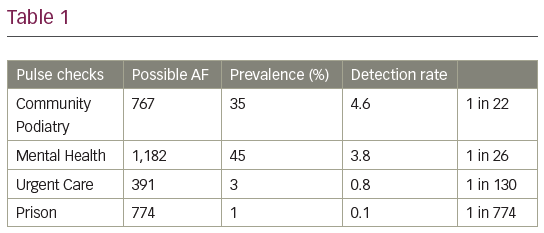Introduction: One in 5 strokes in the UK are caused by atrial fibrillation (AF) and are associated with greater disability and mortality than non-AF strokes (SSNAP, 2017). Early detection of AF can reduce stroke due to timely initiation and optimization of treatment, yet it is estimated that 500,000 people in the UK have undiagnosed AF (PHE, 2015). The number of people needed to test for unknown AF is approximately 1 in 71 people aged >65 (1.45%) (Lowres et al., 2013). With the advent of mobile ECG devices, it is increasingly possible to provide opportunistic testing for AF in novel settings.
Method: Through a national Academic Health Science Network (AHSN) project to increase detection of AF, Health Innovation Network as the AHSN for south London, welcomed expressions of interest from local CCGs and networks to trial mobile ECG devices for opportunistic testing for AF within their practice. Kardia Mobile (Alivecor. Inc) single lead ECG devices were used in a range of novel settings across south London with the aim of understanding which were most effective in detecting possible AF. Device usage was reported monthly by Alivecor through the national AHSN Network project.
Results: A total of 3,114 pulse rhythm checks were performed across four novel settings across variable timeframes between January 2018 to March 2019, detecting 84 cases of ‘possible AF’. This equates to a detection prevalence of 2.7%, or 1 in 37 people tested. The breakdown of pulse checks and possible AF by each setting can be seen below.
Conclusions: Community podiatry and mental health settings were more effective in detecting possible AF using mobile ECG devices, with a detection rate greater than the 1 in 71 (1.45%) in >65 s reported by (Lowres et al., 2013). The increased possible detection rate observed may be due to patients in these settings being older, and often with existing cardiovascular risk factors, whereas the population in urgent care and the prison were generally younger. Data is not available on how many of those identified with possible AF went on to receive an AF diagnosis and treatment, but with the high sensitivity and specificity of the Kardia Mobile device, one would expect the conversion to be high. Effective communication of positive findings to those being tested is key to reduce anxiety. A clear referral pathway that enables timely 12-lead ECG, diagnosis and treatment is paramount if a reduction in AF-related strokes is to be achieved.








